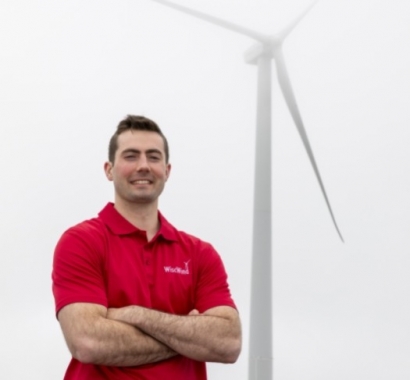
Not so for Joe Brunner, a recent civil and environmental engineering graduate from the University of Wisconsin – Madison (UW Madison). Brunner was offered a full-time position with Invenergy before he even began his senior year.
Brunner credits this early job offer to his participation in the U.S. Department of Energy’s Collegiate Wind Competition (CWC), which aims to prepare undergraduate students from multiple disciplines to enter the wind energy workforce by providing real-world technology experience. CWC presents students with two challenges: design, build, and test a wind turbine; and plan and financially analyze a wind plant.
Brunner joined UW Madison’s CWC team as a junior and competed in the 2018 competition and the 2019 CWC Technical Challenge. Two months after joining the UW Madison CWC team in his junior year, Brunner applied for an internship with Invenergy. By the time the competition rolled around in May 2018, Brunner’s two pursuits converged when he met Connor Kobeski of Invenergy. Kobeski was a judge for the siting challenge during the competition in 2018 and coincidentally also on the renewable energy team that Brunner would be joining at Invenergy.
“The Collegiate Wind Competition offers such direct, applicable experience to what we do in the industry, both on the technology design side and the development side,” says Kobeski. “It’s great experience for people who are interested in getting into the industry.”
Brunner found the specific challenges he faced in the competition useful in his internship. He focused on wind resource analysis, data modeling, building templates to improve processes, and data analysis; he even found himself using the same software—OpenWind—that he used in CWC to design a wind plant. Invenergy had already provided training on how to use the software during CWC.
“It gave me experience on real projects that I was able to take directly to the internship. A lot of people do master's programs for this kind of experience. The competition connected me with professors, industry professionals, environmental permitting people, and community members in ways I wouldn’t have otherwise,” says Brunner.
At the conclusion of his summer internship, Brunner formally applied for a full-time position with Invenergy following graduation. He was offered the job based on the strength of his previous experience in both the CWC and the internship. He feels that both experiences gave him a leg up over other engineers who might have to learn on the job since he already had much of the training he needed and could hit the ground running.
“Getting this experience is unique and not something you get from classes alone. Renewable energy is a specific side of energy and I didn’t find a ton of opportunities in college to get experience,” says Brunner. “The Collegiate Wind Competition really helped get my foot in the door to work in renewable energy. The competition was a way to differentiate myself from other applicants.”
CWC’s connection with the American Wind Energy Association (AWEA) also provided further opportunities for learning as the full competition is held at AWEA’s WINDPOWER Conference, giving participants new inroads to the industry.
“AWEA opened my eyes to how massive wind energy is and how many smaller industries it involves,” Brunner says. “There were hundreds of companies. It was really refreshing to realize how many jobs this could create, how many people could get involved, and all the different skill sets you could use if you want to be in this industry.”
Photo: Joe Brunner on the University of Wisconsin – Madison team during the 2019 Collegiate Wind Competition Technical Challenge, held in Boulder, Colorado, in May 2019.

